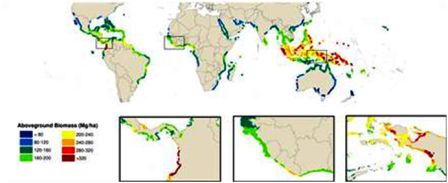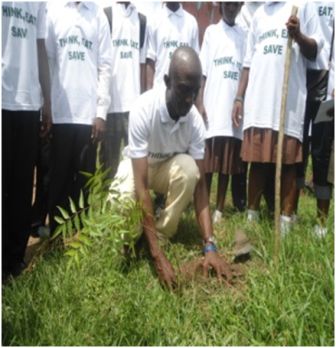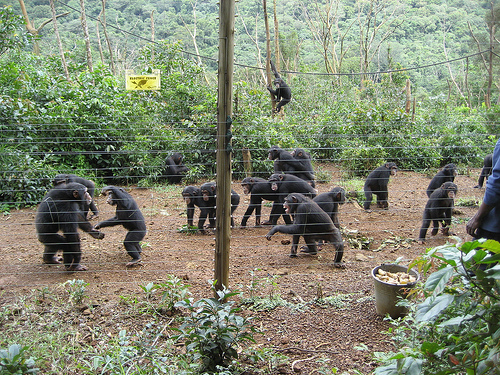Not all mangroves are identical: new study reveals hotspots for mangrove biomass
Cambridge, UK. A new study maps out the amount of carbon stored by mangrove ecosystems in various parts of the world. (Photo: Mangrove carbon map from Hutchison et al (2013). Greatest biomass is concentrated in the wetter and more equatorial regions of the world, notably Southeast Asia and through to the Solomon Islands.)
The fact that mangroves are one of the most carbon-rich ecosystems on the planet was already well known. Now, a new map and model published in Conservation Letters actually pinpoint how much carbon is stored in different mangrove areas around the world. Understanding this variability is critical in developing policies and in prioritising efforts to secure and even expand these carbon stores.
The new model used by the team of researchers allowed them to map out the variance among the different mangrove forests world-wide and to pinpoint which mangrove areas have the highest amount of carbon. While all mangroves are important in terms of carbon, some ranked particularly high – for instance, the mangroves in Sumatra, Borneo and New Guinea, as well as on the Pacific coast of Colombia and in Northern Ecuador.
“These results can help guide decisions regarding priority areas for the conservation and rehabilitation of mangroves for climate change mitigation”, emphasised author Mark Spalding, principle investigator on the project and marine scientist at The Nature Conservancy.
The model is built up on the work of field-scientists, and draws on studies from 35 countries. “This hard work on the ground by researchers lays the foundation for the task of modelling” said lead author James Hutchison of Cambridge University. “But it is through the combination of their many stories that we can build up a bigger picture and extrapolate to areas where no-one has actually worked.”
Mangroves and climate change mitigation

Photo: Mangroves in Berau, Indonesia. These are being rapidly converted to aquaculture ponds. Photo by Mark Spalding
Like all plants, mangroves capture carbon dioxide (CO2) from the atmosphere and store it in their leaves, roots and trunks (their biomass), and in the soil. But unlike most other forests, mangrove soils do not have a maximum storage capacity, but continuously keep on storing carbon in the soil, where it can be stored for centuries or even millennia. In this way, mangroves actively contribute to mitigating climate change, by continuously removing greenhouse gases from the atmosphere.
Furthermore, mangroves are extremely productive ecosystems – even more so than most other tropical forests. Therefore, they can increase their biomass faster, trapping even more carbon than their counterparts. The model used by the researchers indicates that mangroves contain 1.6% of the total tropical forest biomass, even though they only occupy 0.6% of the total tropical forest area.
When mangrove forests are cut down for timber or converted to agriculture or to aquaculture ponds the vast majority of the carbon in their biomass and soils is released into the atmosphere, joining the other sources of greenhouse gases that are driving climate change. Their very high biomass means that clearing even small tracts of mangrove generates high volumes of CO2.
Thus, although they make up only a relatively small fraction of the world’s forests, mangroves pack a punch when it comes to both the total amount stored and the rate of sequestration of carbon. On an area basis it is therefore clear that investment in mangroves makes resounding sense.
Wide range of ecosystem services
“But there are many other good reasons to keep the mangroves we still have and rehabilitate the ones we have degraded”, Spalding recalls. “Mangroves provide timber, fish resources and coastal protection functions worth millions of dollars. Maintaining these ecosystems is an absolute win-win strategy”.
Unfortunately mangroves are being lost at far greater rates than most other forest types world-wide. Wetlands International and The Nature Conservancy are working together to document the ecosystem services provided by mangroves and to promote management options that maximise those services.
To find out more, please see When Green is Blue.
Stay with Sierra Express Media, for your trusted place in news!
© 2013, https:. All rights reserved.






